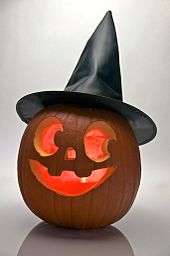Witch hat

A witch hat, in popular culture, is the style of hat characterized by a conical crown and a wide brim (like akubras and gats).
Origins and design
Many woodcuts made during the Middle Ages show witches wearing a variety of different hats, such as headscarves, or witches not even having any headwear at all and instead showing their hair being windblown.[1] In a lot of modern art, witches are often seen bareheaded or wearing headbands with religious symbols printed on them, such as crescent moons. In religious art, priestess of the highest power wear a headband as their crown, while the highest-power male priests wear helmets with horns or antlers.[1]
The origins of the witch hat as commonly displayed today is unknown, but there are several theories. One is that it might have been an exaggeration of the dunce cap or the edgeless hats the Puritans and the Welsh wore.[1] Church despised pointy hats given that the points were often related to those of the devil's horns.[1] The witch hat is a more brimmed version of the cone-shaped hats commonly worn by male-gendered wizards and magicians, as the hat was more brimmed for it to be female-appropriate.[1] As of the Victorian era, fairy tales began depicting black-colored conical hats and crones as symbols of wickedness in their illustrations.[1] Another possibility is that in Luna, a town of the Etruscan civilization, there were coins on one side depicting a goddess commonly associated with witches, named Diana, wearing a brimless, cone-shaped hat.[1]
Another possible reason for the hat's cone shape, as well as the horns of the male priests that the Wiccan goddesses also wore, is that pointed objects, such as a church spire or a minaret, can make electrostatic energy, which can help the witch have psychic abilities.[2]
In media
This hat has been worn by the following fictional characters:
- The Wicked Witch of the West, from The Wonderful Wizard of Oz, 1900
- Gandalf, from The Hobbit and The Lord of the Rings, 1937
- Orko, from He-Man and the Masters of the Universe, 1983
- Minerva McGonagall, from Harry Potter (including a character that is itself such a hat), 1997
Depending upon the material in which the hat is made, the crown may regularly be observed in a flexed, bent or crumpled condition.